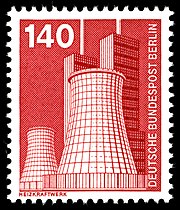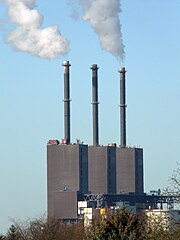Lichterfelde thermal power station
| Lichterfelde thermal power station | |||
|---|---|---|---|
| Lichterfelde power plant with the Teltow Canal in the foreground (2011) | |||
| location | |||
|
|
|||
| Coordinates | 52 ° 25 '32 " N , 13 ° 18' 36" E | ||
| country | Germany | ||
| Waters | Teltow Canal | ||
| Data | |||
| Type | Thermal power station | ||
| Primary energy | Fossil energy | ||
| fuel | natural gas | ||
| power | 432 MW electrical output and 650 MW thermal output |
||
| operator | Vattenfall Europe Wärme AG | ||
| Start of operations | 1972 | ||
| Chimney height | 158 m | ||
| Energy fed in per year | 720 GWh | ||
The Lichterfelde combined heat and power plant is a combined heat and power plant ( CHP ) in the Berlin district of Lichterfelde . It is essential for supplying the south of Berlin with electricity and district heating ; around 100,000 households in the west of Berlin are supplied with district heating from this HKW.
Today's gas-fired power plant based on the principle of combined heat and power with its 158 meter high chimneys has three blocks, two of which are in operation. It can generate a total electrical output of 432 MW and a thermal output of 650 MW. The power plant, which belongs to the Swedish energy group Vattenfall , is operated by a subsidiary of the German subgroup (see Vattenfall (Germany) ), Vattenfall Europe Wärme AG. It is located on Ostpreußendamm 61, directly on the Teltow Canal ( port of Lichterfelde ).
The combined heat and power plant served as a template for the 140-Pfennig postage stamp of the Deutsche Bundespost's Industry and Technology definitive series in 1975 .
history

Bewag was the client responsible for the power plant, which went into operation for the first time in 1972 . The companies Beton- und Monierbau , Siemens-Bauunion , Grün & Bilfinger and Hochtief were involved in the construction of the combined heat and power plant Lichterfelde 1970–1974 . Since then it has been modernized several times. The three heating blocks were gradually converted from heavy oil to natural gas in 1988, 1997 and 1998 . At the end of 2015, one of the three units was decommissioned.
In 1975, the heating power plant motif of the 140-Pfennig postage stamp of the definitive series Industry and Technology of the Deutsche Bundespost Berlin (issue date November 14, 1975).
In 2012, Vattenfall Europe Wärme AG (VE Wärme AG for short) started building a new gas and steam turbine thermal power station on the open space between the cooling towers of the old thermal power station and the Barnackufer , which is to replace the original power station (see below) .
business
The power plant was originally fired with heavy fuel oil. Unit 1 and 3 were equipped with a flue gas desulphurisation system (FGD) in 1983 . In 1988 Unit 2 was converted to natural gas firing. For the use of natural gas, the HKW was connected to the high-pressure gas supply network (40 bar) via a branch approximately two kilometers long in 1988. In 1991 and 1992 denitrification systems were retrofitted for blocks 1 and 3. In 1997 and 1998, units 1 and 3 were also converted to natural gas firing. After the renovation, the REA could be stopped. In 1999 there was a further independent gas feed on the high pressure side.
After converting units 1 and 3, unit 2 was taken off the grid and should be shut down permanently. Contrary to the original plan, Unit 2 was later put back into operation. Block 2 was finally decommissioned in 2016.
The power plant operated by Vattenfall (Vattenfall Europe Wärme AG) is connected to the grid of the Vattenfall subsidiary Stromnetz Berlin GmbH at the 110 kV high voltage level.
New building
The Lichterfelde thermal power station will be replaced by a gas and steam turbine thermal power station (CCGT thermal power station) based on natural gas. The fuel utilization rate should be increased from 70% to 90%. In summer 2012 the construction of a hot water system with three new hot water generators with 120 MW th thermal output each began.
Construction of the combined cycle plant began in 2014. The combined cycle power plant should be able to decouple via an installed electrical output of around 300 MW el and around 230 MW th . The commercial commissioning of the combined cycle plant took place in May 2019, after two postponements of one year each; the distinctive chimneys of the old power plant will be demolished.
Web links
- Lichterfelde thermal power station on the Vattenfall Europe website
- History of HKW Lichterfelde on the Vattenfall Europe website
Individual evidence
- ↑ a b c d e Lichterfelde thermal power station. Vattenfall AB, accessed November 11, 2017 .
- ↑ a b c power plant list of the Federal Network Agency as of March 31, 2017, accessed on November 11, 2017 (XLSX; 681 kB) .
- ↑ First day sheet 24/1975.
- ↑ The construction project for the Lichterfelde thermal power station . Vattenfall GmbH website , accessed on November 11, 2017.
- ↑ Stefan Jacobs: Lignite phase-out in Berlin 2017 . In: Tagesspiegel , September 27, 2016. Accessed December 19, 2016.
- ↑ For Berlin and Lichterfelde - The new gas and steam turbine thermal power station on Ostpreußendamm ( Memento of the original from April 19, 2015 in the Internet Archive ) Info: The archive link was automatically inserted and not yet checked. Please check the original and archive link according to the instructions and then remove this notice. , Website of Vattenfall Europe AG. Retrieved April 12, 2015.
- ↑ New Lichterfelde power plant in operation Berliner Morgenpost, May 10, 2019


